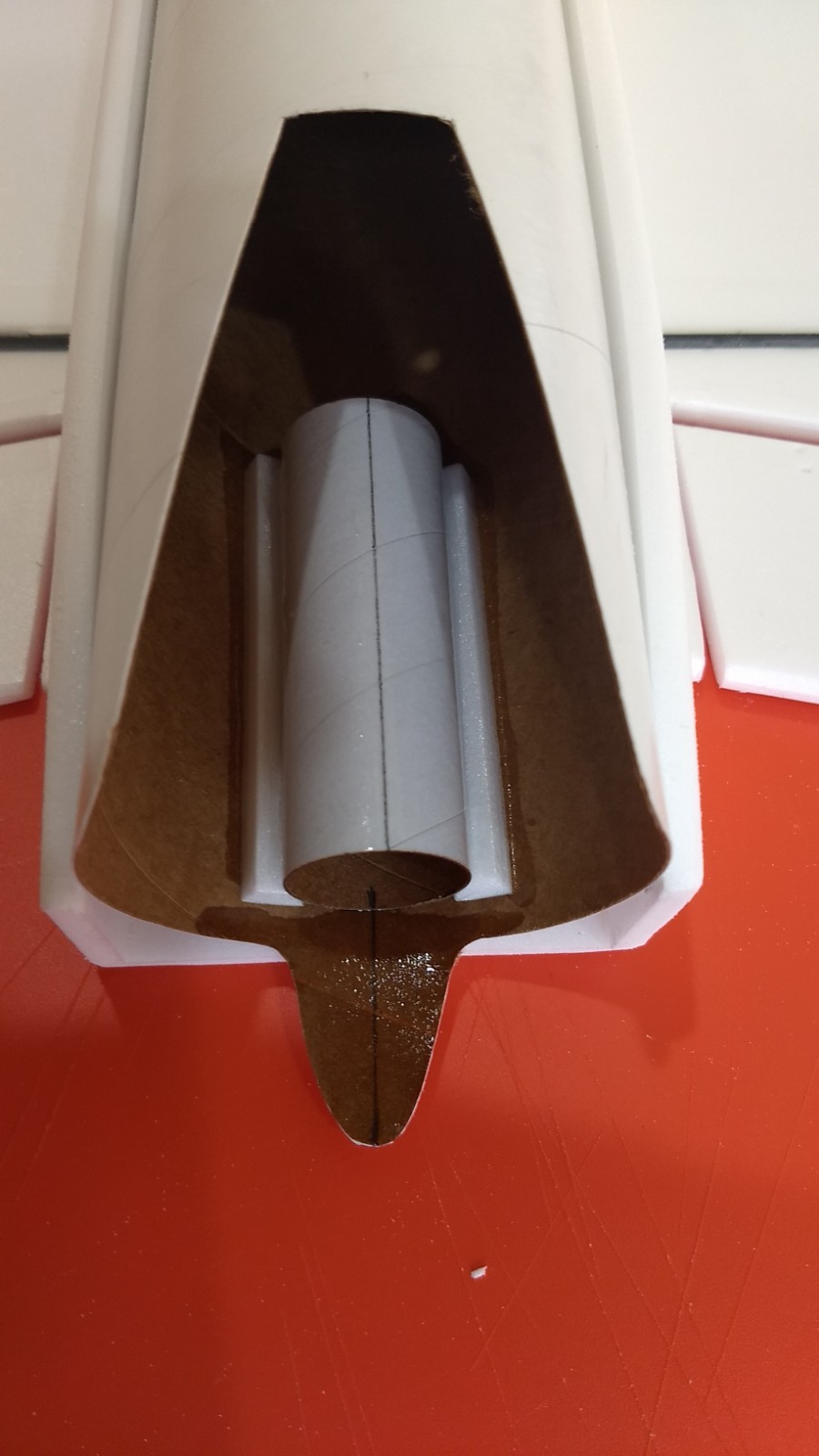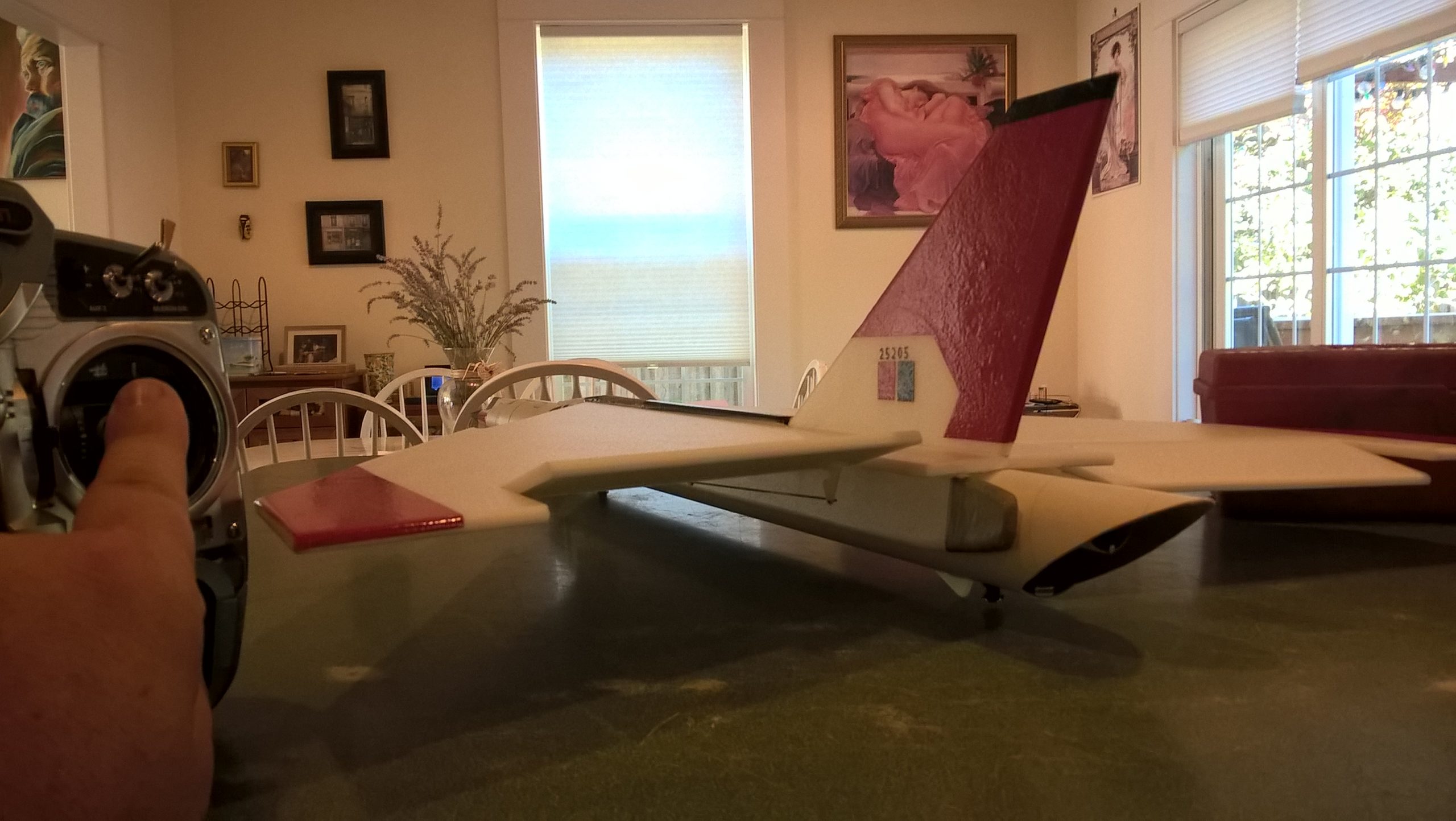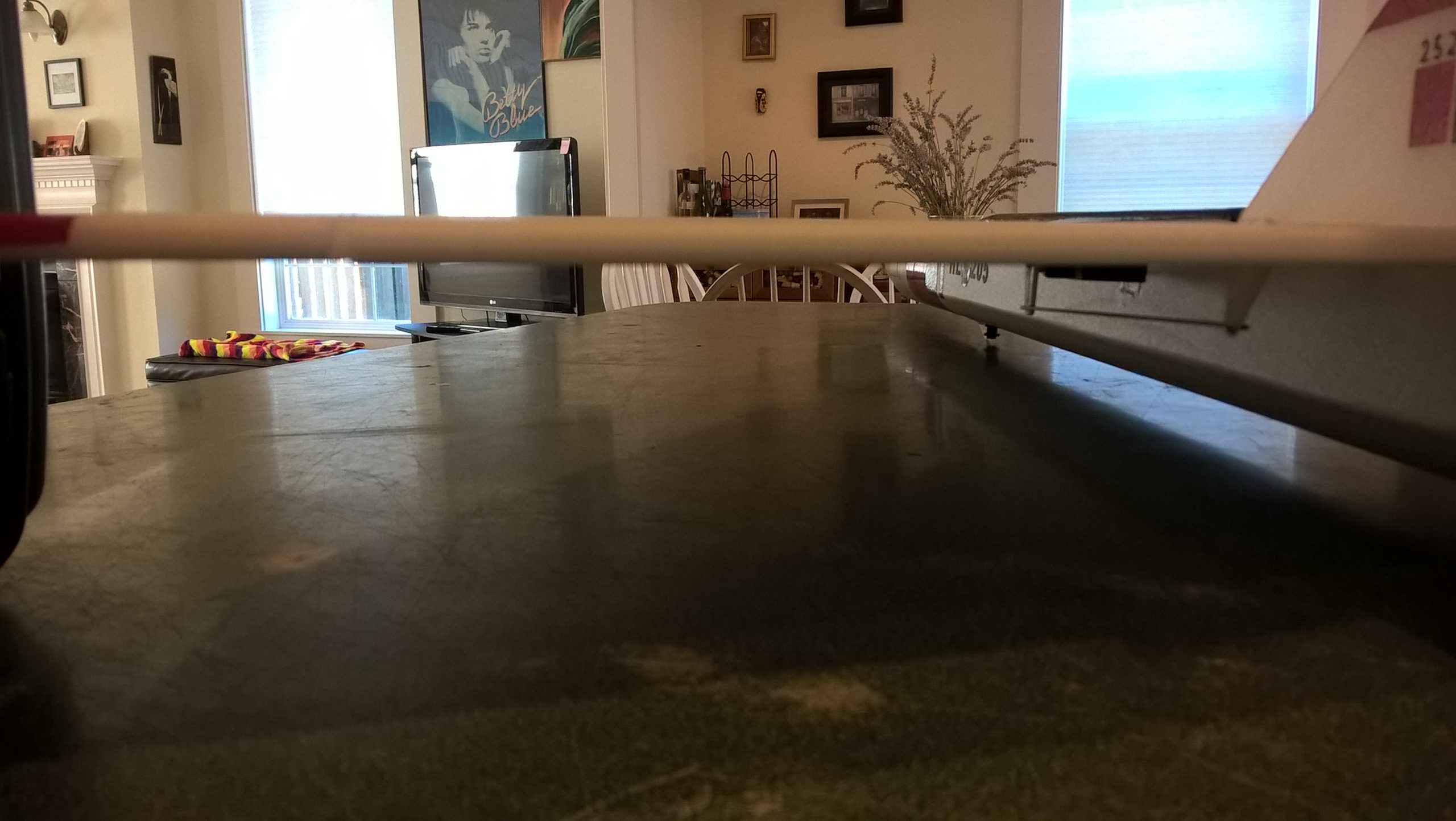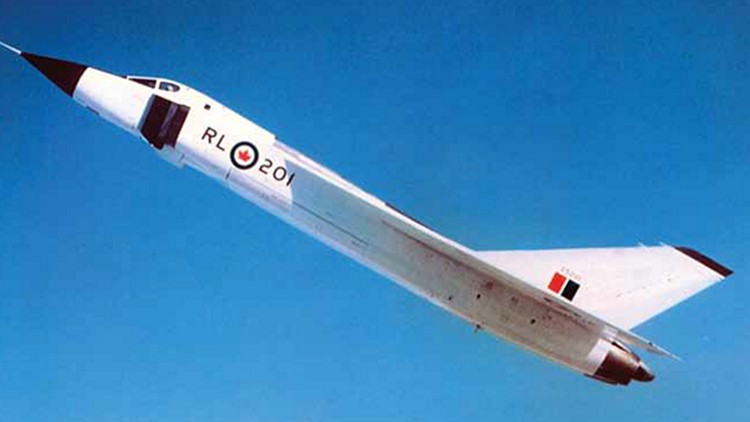
The Avro Arrow RC Rocket glider kit is based on the world beating interceptor developed in Canada. It features a high mounted delta wing with spar pre-installed, a plastic nose cone, 2.6″ white tubing for the body and depron wing and tail surfaces. Wing elevons are pre-hinged. The body tube end is pre-cut at an angle. You will need two 10 gram type servos, two lightweight 12-16″ servo extensions, a receiver, and a small 500mah single cell lipo battery. You will need a transmitter with delta or elevon mixing. Specs: 32″ length, 23.5″ wingspan, 9.8 oz rtf, for 24mm E-6 single use or reloadable motors.
High quality vinyl decals are available HERE:
CG location for rocket flight with battery and loaded motor installed: 3/16″ to the rear of the notch in the wing.”
Please refer to the General Information Link above then read the instructions completely before starting assembly. The assembly photos are for general reference but may not include every step in the instructions. If you want hardcopy to work from, all you have to do is click/drag/select and copy all of the text below, open word and paste with “keep original format” and it looks exactly like it does online then you can print it.
Unpacking your kit:
The kits are packed to protect them in shipping, but the contents are fragile so unpack carefully. Carefully cut the tape holding the tubes in the box, then unwrap/lightly cut the plastic wrap to free the tubes, the spar may be packed in the tubes and the baggie with the little parts and nose cone will be in the tubes as well. Carefully cut the tape holding the cardboard wing protector in the box and carefully remove it, don’t pull hard or bend it. Then carefully cut the tape holding the cardboard top piece to the bottom. There may be some sticky tape holding the cardboard to the bottom cardboard piece, carefully peel it being sure not to bend anything. Once the top cardboard is free you can see the foam wing/tail parts, there are little fragile pieces in here, so unwrap carefully. It may be best to use an exacto to lightly cut the plastic wrap and carefully remove it without cutting into the foam. Make sure everything is free before you remove the pieces to avoid breaking anything. Kits contain one or two scrap pieces for repairs if you damage anything in construction or flight, just cut and patch in a spare piece of the foam if needed using foam safe CA+.
Welcome to the world of rocket boosted radio control gliders. This is not a model for a novice RC pilot, but anyone who is comfortable with RC flying of a medium speed model should be fine. Read through the instructions, look at the photos and be sure you understand the step before commiting to cutting or glue.
Avro Arrow Rocket glider instructions
Identify all pieces, the kit should contain:
1 wing taped together
1 Nose Cone
1 vertical stabilizer
2 control horns w/pushrods
2 2.75″ beveled motor tube supports
1 body tube
Motor mount
2 engine intake side plates.
1 long 3/4″ wide by 13.5″ long tapered conduit/cockpit
3 cockpit pieces
Velcro(for battery and rx/bec attachment)
Lead weight
Spare depron
Notes before starting:
Reference to glue, CA, or CA+ means foam safe CA+, normal CA+ will melt the foam! Normally you need to use accelerator to get the CA to set on the foam since there is nothing for it to soak into and activate.
You may use 320 grit sandpaper and a sanding block to slightly round the edges of the foam if you prefer that look. Be very careful and use a VERY light touch, it is very easy to catch the foam on the edge of the paper and tear the foam. Do any sanding before assembly. I’ve found that using a thin straight edge and exacto knife it’s easier to cut a 1/16″ bevel on the straight edges of the depron instead of sanding as it is less prone to tear or snag the edge, and looks as good as sanding.
Epoxy is not needed in this model. Weight is critical and the model is designed for the thrust and flight loads.
Assembly:
- I found building my model that if using vinyl, it is easier to apply it to the wing, tail, conduit, cockpit and intakes before assembly since you can do it on a flat surface. The tail pieces are cut slightly over sized to allow you to wrap around the front and rear of the stabilizer and to then trim the top even with your rudder. This allows for differences in sanding/rounding, etc. Covering the stab with vinyl also adds a lot of strength and stiffness to the stabilizer.
- After applying the stickershock vinyl trim, use a hot hair dryer to soften the vinyl and press down with a thumb or finger to press it in place, this makes it conform and really attach to the foam.
- Unfold the wing and apply glue to the wing at the taped joint and set it on a flat surface to dry face up. Then flip the wing over, the bottom of the wing will have the spar visible.
- Lightly sand the fuselage wing line and apply a squiggle of glue about 1/2 wide to the body tube wing line.
- Lay the body tube on the upside down wing. The front of the body tube should be even with the front of the wing. Use the alignment marks on the front and rear of the wing and inside of the body tube. Make sure it is set before continuing.
- Glue a motor intake side plate to each side of the body tube and onto the wing. The front of the intake should be even with the front of the wing.
- Glue the motor tube onto the inside top of the body tube on the line marked, the rear end of the tube will be about 1″ from the rear of the tube. Once set, glue a foam reinforcing strip on either side of the motor tube. On my model I saw no burning of the rear of the tube, but you can apply a coating of CA to the body tube to the rear of the motor tube to make sure it is protected and to stiffen it.
- Install the t-nuts and rail buttons into the bottom of the body tube using the pre-punched holes. Insert the t-nut from the inside and hold it with your finger, install a washer, collar, then another washer then the screw, don’t tighten down really hard, just enough so it is snug.
- Test fit the vertical tail into the slot and make sure it fits. Make sure the tail is straight with no warps, bend carefully by hand to straighten it if needed. Glue into the slot using foam safe CA+ making sure the tail is perpendicular to the wing and is straight.
- Round the long tapered conduit piece and cut the rear to an angle to match the tail. Glue the conduit on the top of the wing, and trim the front even with the front of the wing.
- Glue the three cockpit pieces together. At this point shape the cockpit referring to the picture making sure the rear of the cockpit matches the contour of the conduit glued to the wing. With some 220 or 320 grit sandpaper wrapped around the cone, sand the bottom of the cockpit assembly to match the contour/shape of the cone. Go slow and take your time.
- Glue the cockpit to the top of the cone so it butts against the conduit/front of the wing, careful not to glue the cone in place when you do this.
- Glue each control horn/pushrod in place on the bottom of the control surface using the pre made holes. The control horn holes should be pointing toward the front of the model and the pushrod should be closest to the model and angle inward slightly. Repeat on the other side.
- Put some CA on the top of the control surface where the horn prongs stick through, this locks it in place
The basic construction is now complete.
Radio Installation
Note: Your radio needs to be configured for Delta mixing, this means that the servo arms will move the same direction during elevator stick movement and opposite for aileron stick movement. Connect your servos to the receiver one in the aileron connection and one on the elevator connection and apply power. Use a servo arm at least 9/16” long and with holes small enough that there won’t be slop with the pushrod wire when installed. I use the hole furthest out on the servo arm, to maximize movement. On some servos there are a long two-ended servo arm, you can trim off one end if needed to get sufficient length. Zero out any trim settings on the transmitter. The model once the motor has burned out is nose heavy and flying wings lose pitch authority when nose heavy so you want as much up elevator travel for trim/flare as possible.
- Connect a servo to each pushrod. If the pushrod is too tight, you can use twist an exacto knife in the servo arm hole to make it larger, but be careful and do not make it too large. Connect the servo extension to the servo and attach to the rx and power the radio on. Once connected, tape each servo in place so that the control surfaces are centered. Flip the model right side up and look at it from the rear. Moving the transmitter stick back(up elevator) should move both elevons up. Moving the transmitter stick to the right should move the right elevon up and the left elevon down. If you can’t get the servo reversing to give you the right polarity try swapping aileron/elevator inputs to the receiver or turning the servos over and swapping the servo arms to the other side of the output shaft. If that is correct, continue.
- Flip the model upside down and supported. Mark where the servos will be located when the radio is on and the surfaces are neutral.
- Cut a pocked for the servo in the intake side plate. Cut a 1/8″ wide by 1/2″ slot into the body tube to pass the servo wire through to the front of the model.
- Disconnect the servo from the rx, pass the wire to the front of the model and re-attach to the rx, repeat on the other side and power the model up again.
- Keeping the surface neutral insert the servo into the pockets you cut. Trim the pocket as needed to allow the control surface to remain neutral. Use foam safe CA glue to glue the servos in place making sure not to get any glue on the output shaft.
- Flip the model back right side up. Make sure the control surfaces are centered, use trims if needed. Now measure the control surface movement. Full elevator movement should be 1” in each direction, aileron movement should be 1/2″ in either direction. Since the model will be nose heavy, extra elevon movement helps to give sufficient authority during glide.
- If you have a flap/elevator mix you can program up elevator to a switch setting. The model needs approximately 1/4″-5/16” of up elevon during glide. If you can’t set the up elevator trim to a switch on your radio you’ll have to manually put in boost and glide trim which is hard to do while flying the model. My model needed just a small amount of down trim for a straight boost.
- Use the included Velcro to attach the receiver inside the top front of the body tube inserted about 3″ from the front, enough for the battery wire to reach the battery.
- Use the rest of the velcro to attach the flight battery to the bottom inside of the nose cone shoulder.
- Insert your heaviest loaded rocket motor into the motor mount
- Support the model right side up at the balance point indicated above for CG location. Glue lead weight in the nose or tail as needed to balance it slightly nose down. Do not try to fly the model with it balancing it behind this point or significantly nose heavy. The adage is, a nose heavy model flies poorly, a tail heavy model flies once.
- There were several paint schemes from mostly white to multiple red areas, I chose number 205. Using the pictures below you can see differences in markings on the tails and wing walk lines, even between the same aircraft at different times in the flight program.
- Refer to the general instructions tab if you decide to paint the foam areas, I ONLY recommend testors or model master ENAMEL spray.
- You can use the following templates to cut your own vinyl HERE.
- The nose cone is curved can be masked and painted as shown. The black section goes from the rear of the forward cockpit window to about 1.25″ ahead of the front of the cockpit and about 1/4″ on either side of the cockpit. The red goes from just below the black to 1.25″ ahead of the cockpit.To the rear of the forward cockpit window is left unpainted and should be masked along with the cockpit when you paint. The black intake splitters are simulated with trim vinyl or paint and go ahead of the side intakes and on both sides of the nose cone as shown in the pictures. I added an extra silver detail with a silver sharpie on them after they were installed.
- The tail and wingtip markings are slightly oversized to allow you to fit and wrap and trim them a bit to go around the edges.
- I used black paint on the front of the intakes.
- The side roundels are 3/4″ tall, the wing roundels are 2″ tall. The lettering RL205 is 1/2″ tall. The small tail marking are black and red rectangles with 25205 above in 3/16″ letters in black.
- I added a little more detail using a silver sharpie on the spine conduit and cut a little notch on the top, I also added silver sharpie on the rear of the side plates and body tube extension. I used a fine line sharpie pen and clear straight edge to draw some panel lines based on the drawing below. I also used some fine line pin strip or vinyl trim to add the don’t walk pattern on the top of the wing.
- Once applied, use a hot hair dryer to soften the decals and push them down with your finger to set them into the foam surface.
- Make a final verification of control movements and throws and balance before the first flight.
Flying: See the General Information link at the top for flying instructions. Be ready on the first few flights to keep the model straight till you have the trims set perfectly for boost and glide.
- glue the taped joint on the wing then lay flat to dry
- Lay wing flat to dry then apply glue down the center of the bottom of the wing(the part where the spar is visible)
- Glue the body tube to the wing with the front of the tube even with the front of the wing.
- add the two side plate/intakes on each side, even with the front/rear of the wing.
- Glue the motor tube in place on the line marked, approx 1″ from the end of the body tube extension.
- add in the reinforcing strips on either side of the motor mount.
- Glue the vertical stab in place.
- install the front rail button
- install the front and rear rail buttons
- glue the pushrod/horns in place in the holes pre-punched in the bottom of each surface, note the pushrod is closest to the body tube and angle inward on each side.
- add a bit of glue on the horn prongs to lock them in place in the top of the control surface.
- Cut the notch for the servo in the side plate and servo wire in the tube.
- install the servo so surface is neutral.
- shape and glue on the spine conduit.
- glue the three cockpit parts together, then shape and fit to the nose cone, and glue in place when complete.
- Conduit shape and decal
- Showing how conduit is cut to match vertical stab when gluing in place.
- Completed Model
- Top View
- left aileron
- right aileron
- up elevator
- down elevator
- glide trim
- boost trim
- neutral trim
- 3-view for panel line ideas.































